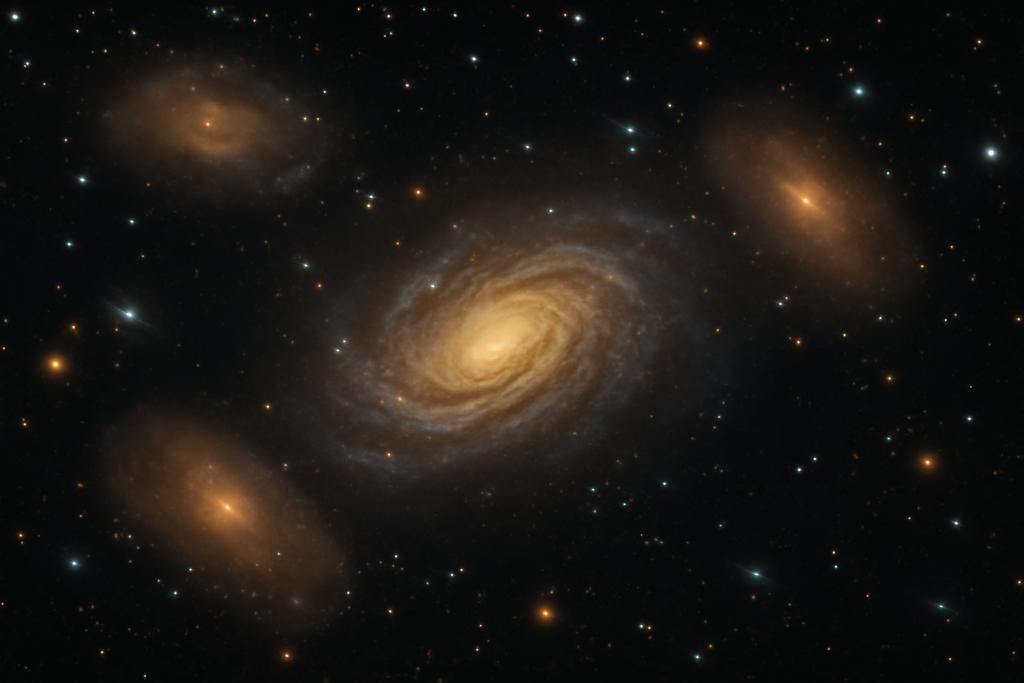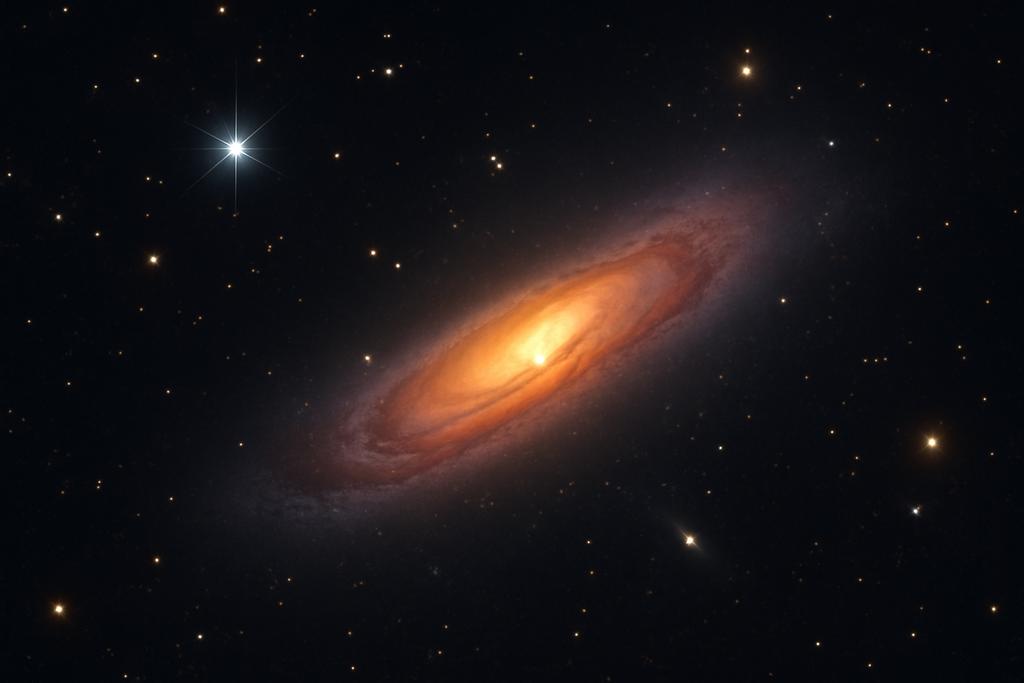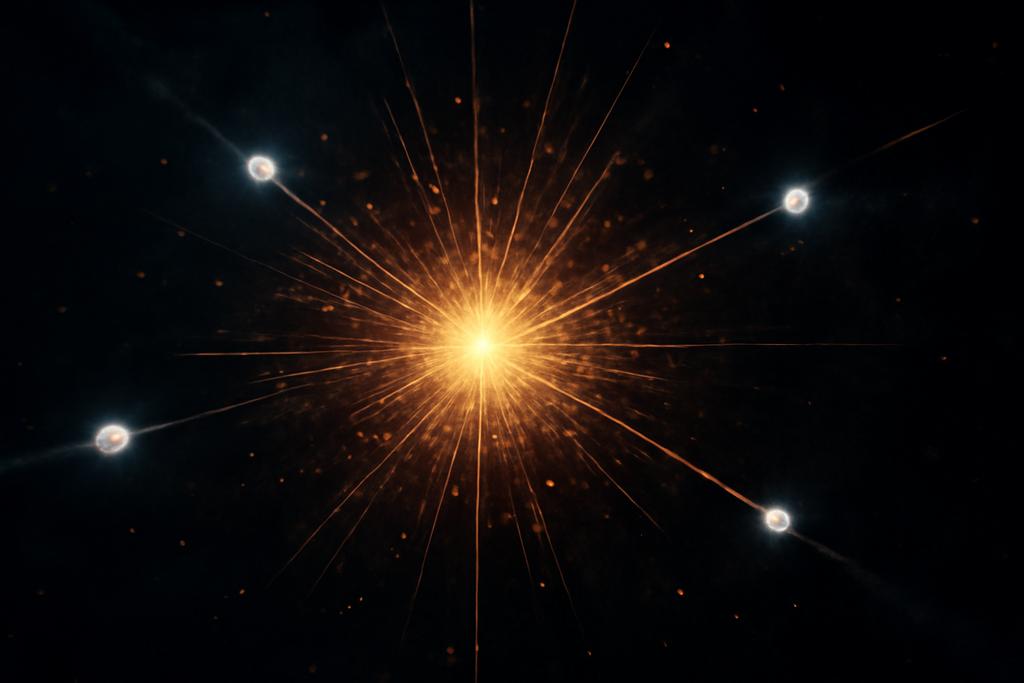In the quiet corners of the early universe, galaxies weren’t always blazing star factories. Some paused mid-song, their light carrying evidence of a recent quiet spell that the cosmos scarcely seemed to notice. The James Webb Space Telescope is letting us listen to this whisper, not just the roar of newborn stars. A new study dives into the JWST/NIRSpec archive to hunt for these dormant galaxies at redshifts around five to seven, revealing a population that challenges simple pictures of early galaxy life.
The work, led by Alba Covelo-Paz of the University of Geneva, with collaborators spanning the Cosmic Dawn Center (DAWN) and European institutes, shows that galaxies can switch off their star formation in a surprisingly short window and across a surprisingly wide range of masses. By chasing the spectral fingerprints of the past—weak Hα lines and pronounced Balmer breaks—the team identifies a cohort of dormant galaxies that sit roughly a decade below where the star-forming main sequence would place them. It’s not just a handful of quiet giants; it’s a spread of intermediate-mass systems that tell a more continuous story of how galaxies live and breathe over cosmic time.
Think of this as listening for a pause in a symphony rather than the crescendo. The universe is not simply a collection of galaxies that start bright and fade away; it’s a dynamic chorus with bursts, lulls, and reawakenings. The new results suggest that dormant phases are a regular, perhaps even predictable, part of that cycle, not an exception reserved for only the most massive or most diminutive systems. If you want to understand how galaxies regulate their own fuel supply, you need to hear what turns them off—and, just as crucially, how they might turn back on again.
A new population beneath the main sequence
The study combed through the public JWST DAWN Archive to assemble a catalog of galaxies at 5 < z < 7.4 for which the rest-frame Hα emission is faint or absent and the Balmer break is strong. The Hα line is a flashlight from recent star formation: it lights up when hot, young stars ionize surrounding gas. When a galaxy has halted star formation, Hα fades, and the underlying continuum reveals a Balmer break—an abrupt change in the spectrum around 4000 Å that signals a stellar population older than a few tens of millions of years. By requiring Hα rest-frame equivalent widths below about 50 Å and a Balmer-break strength (Fν,4200/Fν,3500) above 1.4, the team could isolate galaxies that are in the midst of quiescence rather than simply dusty, obscured star formation.
The 14 dormant galaxies that emerged from this spectral sleuthing span stellar masses from roughly 10^7.6 to 10^10.5 solar masses. That range matters: it crosses what some simulations and early ideas treated as a gulf between tiny, “mini-quenched” systems and a single, massive quiescent population. Instead, these objects populate an intermediate mass regime, about 1 dex below the star-forming main sequence, and they share a common thread: their star formation has been paused within the last ~10–25 million years. The Balmer breaks are strong across the sample, while the Hα lines remain weak, a combination that speaks to a recent, abrupt downturn rather than a slow fade.
The sample’s redshifts cluster between 5.04 and 6.78, with morphologies ranging from compact to more extended, and several galaxies showing close companions. That diversity hints at a broader, perhaps environment-influenced, story of how quenching plays out in the early universe. The team’s analysis also notes that these dormant galaxies lie about one dex below the main sequence, reinforcing the idea that quenching is not a rare, isolated phase but a measurable, recurrent state across a spectrum of masses. It’s a reminder that the universe’s history isn’t a straight line from bright to dim; it’s a zigzag of activity and quieting, with each pause leaving a spectral trace for us to read.
How JWST unlocked the dormant phase
The backbone of this discovery is the JWST/NIRSpec prism data, which permit simultaneous glimpses of the rest-optical continuum (where the Balmer break lives) and the Hα emission line at these redshifts. The authors constructed a robust catalog from publicly available prism spectra that cover the wavelength region containing Hα for z ≲ 7.4. They required robust redshifts (grade 3 spectra in the DAWN archive) and, importantly, excluded broad-line active galactic nuclei so as not to confuse an AGN’s spectrum with a galaxy’s star-formation history. In all, nearly 1,600 galaxies in the archive met the initial criteria, giving the researchers a broad canvas on which to search for the quiet phase.
To translate the spectral data into physical storytelling, the team paired the spectroscopy with multi-band photometry from JWST’s near-infrared camera (NIRCam) and, where available, archival Hubble data. They then fit the combined spectra and photometry with Bagpipes, a widely used spectral-energy–distribution (SED) fitting tool. This step is crucial: it lets researchers reconstruct star-formation histories (SFHs) while accounting for dust, metallicity, and the uncertain details of how stars formed over time. The redshift was fixed to the spectroscopic value, and the modeling used BPASS stellar populations with a continuity prior for the SFH, which helps avoid pushing the solution toward unrealistic bursts or smooth histories. The researchers also allowed for a modest bump in the dust attenuation curve and a range of metallicities, so the inferred histories could survive reasonable degeneracies between age, dust, and metallicity.
One of the most practical parts of the method is how the team defined “dormant.” They first simulated model galaxies that had formed stars for 100 million years, then turned star formation off, to see how Hα and Balmer breaks would evolve. Across a grid of metallicities, those models showed that once a galaxy has stopped forming stars for more than 10 million years, its Hα equivalent width generally falls below 50 Å, while the Balmer break grows to values above 1.4. In other words, Hα fades quickly after the star formation halt, but the Balmer break lingers as a fingerprint of the recently quenched population. This combination is the heart of the selection: a spectral signature that can be detected directly in prism spectra without requiring detailed, high-resolution observations.
From there, the researchers built their sample by picking sources that exhibited the dual hallmarks—low Hα EW and a pronounced Balmer break—while avoiding dusty impostors. The result is a clean, empirical window into galaxies that have shut off recently, not long enough ago to erase the memory of their earlier star-birth episodes. The approach is a testament to JWST’s power: it makes spectral features at the edge of cosmic dawn accessible, and it turns archival data into a new kind of census that would have been hard or impossible to assemble even a few years ago.
What this tells us about galaxy lifecycles
The SFHs derived for the 14 dormant galaxies tell a striking story. Across the sample, star formation halted between roughly 10 and 25 million years before the time of observation. In most cases, the galaxies had been on a rising star-formation trajectory before this abrupt stop, consistent with the idea that bursts can be triggered by internal processes or external triggers and then shut off on short timescales. There’s an outlier—one galaxy showing a downturn beginning about 250 million years before observation and continuing thereafter—that hints at more complex dominant mechanisms in at least some systems. Still, the dominant pattern is a clean pause in activity after a relatively brief period of growth.
The team’s reconstruction of SFHs also yields a telling statistic: the galaxies’ current star-formation rates, when compared to their histories, are suppressed by factors typically well below 1, and the look-back times place the quenching event in a universe that was a fraction of its present age. The mass-weighted ages of these dormants cluster around a few hundred million years, implying that most of these galaxies formed the bulk of their stars relatively early, then experienced a recent cessation of star formation. In that sense, these aren’t pristine, pristine-early-universe objects; they are mature systems living a fleeting, off-state within a much longer life cycle.
Another key result is where these galaxies sit relative to the star-forming main sequence. All of the discovered dormant galaxies lie below the main sequence, by about a factor of a few in SFR at fixed mass, with a surprising continuity in mass: the sample spans roughly 10^7.6 to 10^10.5 solar masses. This undermines a simple, two-population picture where only tiny dwarfs or the most massive galaxies quench. Instead, there appears to be a continuum of dormant objects across a broad mass range, suggesting that the processes leading to quenching—whether self-regulated feedback, gas supply fluctuations, or environmental effects—can operate across different scales. The authors even note that the most massive object in the sample, despite its relatively quiet current state, continues to show a dust-laden, UV-redder signature that hints at a more complicated recent history.
These patterns dovetail with theoretical expectations from simulations that forecast short-lived, recurrent dormant phases in bursty star-formation histories for high-redshift galaxies. For instance, models have suggested that galaxies in the 10^7–10^9 solar-mass range should experience bursts and quiescent intervals on timescales of tens of millions of years. The JWST data provide a direct, spectroscopic glimpse of those cycles and link them to observable features like the Balmer break. It’s as if we’re watching a cosmic heartbeat: a rapid surge, a quiet spell, and then a potential revival, all imprinted in the spectrum we can measure with precision.
One broader implication is that dormant phases are not an odd footnote in the history of early galaxies but a tangible mode that can occur across a wide mass range. If many galaxies flicker off for a while, star-formation histories might be more “breathing” than previously thought: a cycle of rises and pauses driven by internal regulation of gas, feedback, and perhaps subtle environmental nudges. This has consequences for how we interpret the cosmic star-formation history, the buildup of stellar mass over time, and the transition to the long-lived quiescent population that dominates later epochs. It also invites a fresh look at the dynamics that sustain or suppress gas inflows, the role of dust in shaping observed spectra during quiescent periods, and how quickly a galaxy might resume star formation after a lull.
The road ahead for distant, quiet galaxies
If the results are the first coherent census of dormant galaxies at z > 5, they also mark the beginning of a longer conversation. The authors estimate that roughly 1% of galaxies in the DJA fall into this dormant category during 5 < z < 7.4, a figure that could shift as larger and more complete samples emerge. But that 1% already matters: it demonstrates that dormancy is a real, recurring phase and not a rare curiosity. To quantify how common and how long these off-states last across the full galaxy population, future surveys will need to push beyond the current selection biases. The DJA, while extensive, is not a complete census, and deeper, more uniform coverage will be essential to map the true distribution of dormant galaxies in mass and environment.
Looking ahead, the study’s authors highlight a natural path: extend the spectral clock to higher redshifts by combining lines beyond Hα, such as [OIII] and Hβ, which JWST can access with other instruments or observing modes. This would let us chase dormant galaxies farther back in time, into epochs where the first stars and galaxies were still shaping their surroundings. It would also require careful calibration against simulations to understand selection effects and to translate spectral signatures into robust quenching timescales. The synergy between archival spectroscopy, targeted follow-ups, and state-of-the-art simulations could reshape how we picture the duty cycle of star formation in the early universe.
Meanwhile, the present result already reframes the narrative of galaxy evolution at high redshift. Dormant galaxies are not isolated anomalies; they are part of a broader distribution of star-formation histories that stretches across mass scales and cosmic time. That makes the universe feel more like a bustling market rather than a binary highway: bursts happen, quiet spells intervene, and the next act awaits just beyond the spectral reach of our instruments. The work by Covelo-Paz and colleagues—rooted in the University of Geneva and carried out with the DAWN collaborators—reminds us that to understand the life cycles of galaxies, we must listen for every note, even the rests that seem to whisper rather than shout.
Lead author Alba Covelo-Paz (University of Geneva) and collaborators across DAWN and multiple European institutes demonstrate how archival JWST data can be repurposed into a near-complete census of a crucial phase in galaxy evolution. Their approach—combining rest-frame Balmer breaks with weak Hα emission in the NIRSpec prism data and robust SED modeling—offers a blueprint for future explorations of the quiet, yet narratively rich, chapters of the universe’s galactic story.
Conclusion: a quiet rhythm that matters
Ultimately, this work isn’t just about counting dormant galaxies. It’s about revising our sense of how galaxies live, breathe, and, crucially, pause. The discovery of an intermediate-mass population of dormant galaxies at z ~ 5–7.4—detected through their spectral footprints and traced back to their recent histories—highlights the role of burstiness and self-regulation in shaping the early cosmos. It offers a more continuous, nuanced view of galaxy evolution, one in which off-states are as informative as bright starbursts for mapping the lifecycle of baryons across cosmic time. And it does so with a simple, telling trick: read the spectrum as the galaxy’s memory, and listen for the breath between the lines.








